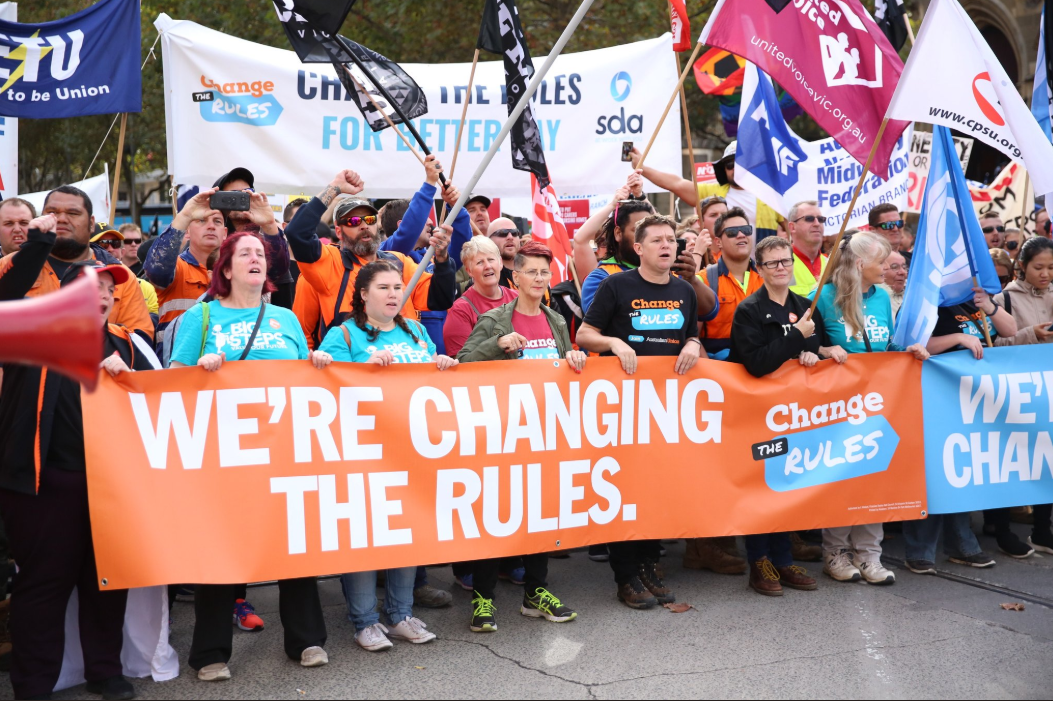The Melbourne March
Australian workers rallied yesterday against repressive labor laws in the largest march in more than a decade.

Union members rally in Melbourne, Australia. Construction Forestry Maritime Mining Energy Union / Twitter
On Wednesday, the largest union rally in more than a decade marched through the center of Melbourne, Australia’s second-largest city.
The demonstration was part of the “Change the Rules” campaign coordinated by Australia’s top union body, the Australian Council of Trade Unions (ACTU). The campaign targets insecure work, below-inflation wage rises, and Australia’s restrictive industrial laws — some of the most repressive in the advanced capitalist world. Australian unions have no right to strike outside the bargaining period: the main construction union, for instance, was recently handed $2.4 million in fines for a two-day strike to protect an unjustly fired delegate and a $240,000 fine for a stoppage of “approximately ten minutes” on a Melbourne construction site.
The campaign also highlights corporate power and tax avoidance (one in three major corporations in Australia paid no tax last year) in what is most likely to be an election year. ExxonMobil’s local subsidiary, Esso, has become a high-profile target of the campaign, after an attempt to slash the pay and conditions of maintenance workers sparked an industrial dispute that has been running for almost a year. Esso has paid no taxes in Australia for three years.
On Wednesday, tens of thousands of construction workers, the bedrock of union mobilizations in Melbourne for many years, left the city’s booming construction sites empty as they defied industrial law and stopped work for the day to rally through the streets. They were joined by contingents of striking workers from the Port of Melbourne, Australia’s busiest container terminal, who also walked out in defiance of workplace laws.
Other groups of workers from the Ballarat railway workshops, Melbourne University, and the government’s Bureau of Meteorology — all embroiled in long-running disputes over contract agreements — took legally protected industrial action to be part of the protest. One of the most impressive contingents was from the National Union of Workers (NUW), where delegations of off-shift logistics workers were joined by hundreds of newly organized farm workers, many of them on strike for the first time. The NUW’s push to organize workers in the country’s multi-billion-dollar fresh-food industry is one of the few systematic union organizing drives in Australia today.
Overwhelmingly, though, the march was made up of small delegations from a vast array of workplaces, both white and blue collar. While most unions didn’t call on workers to strike, the turnout was evidence that if unions do the basics — issue a clear call to action, call delegates, text members, and hold workplace meetings — the movement can still pack a punch.
The march stopped in the city’s court district, where construction-union leaders John Setka and Shaun Reardon are in court this week facing charges of “blackmail” that could see them jailed for up to fifteen years. This is a new and serious legal challenge — unionists who issue an industrial threat during an industrial dispute now risk getting slapped with serious criminal charges.
Mainstream media outlets estimated the crowd at around one hundred thousand, making it easily the biggest union mobilization since the heights of the ACTU’s “Your Rights at Work” campaign of 2005–7, sparked by the conservative government’s “WorkChoices” package of industrial relations reforms. WorkChoices allowed employers to strip core conditions such as penalty payments for overtime and shift work, allowances, rest breaks, and minimum times between shift breaks, in exchange for pay rises of as little as two cents per hour. Union street mobilizations and electoral campaigning were crucial in defeating the government in the 2007 elections, with Prime Minister John Howard suffering the humiliation of losing his own parliamentary seat.
But the fate of the union campaign against WorkChoices serves not just as an inspiration, but also as a cautionary tale for those rallying for union rights a decade later. Though 2005 saw the biggest working-class mobilizations in Australia’s history, the campaign of periodic rallies and strike action gave way to a purely electoral push. “Your Rights at Work — Worth Fighting For” morphed into “Your Rights at Work — Worth Voting For.” And the campaign faded away when the new government, led by the Labor Party (ALP), took power. As everyone from the far left to Melbourne’s Age newspaper points out, the laws workers are protesting today are, in large part, the ALP’s laws from that time. While taking some of the sharp edges off the WorkChoices attacks, the ALP left in place strict limits on industrial action and other workplace rights.
There is widespread awareness of these limitations in the Australian union movement. But judging by the speeches yesterday, there is less willingness to put specific demands on the ALP, or to potentially continue any union campaign into the term of an incoming ALP government. The spectacular display of workers’ power in Melbourne this week shows there is no reason for the union movement to settle for second-best this time around.